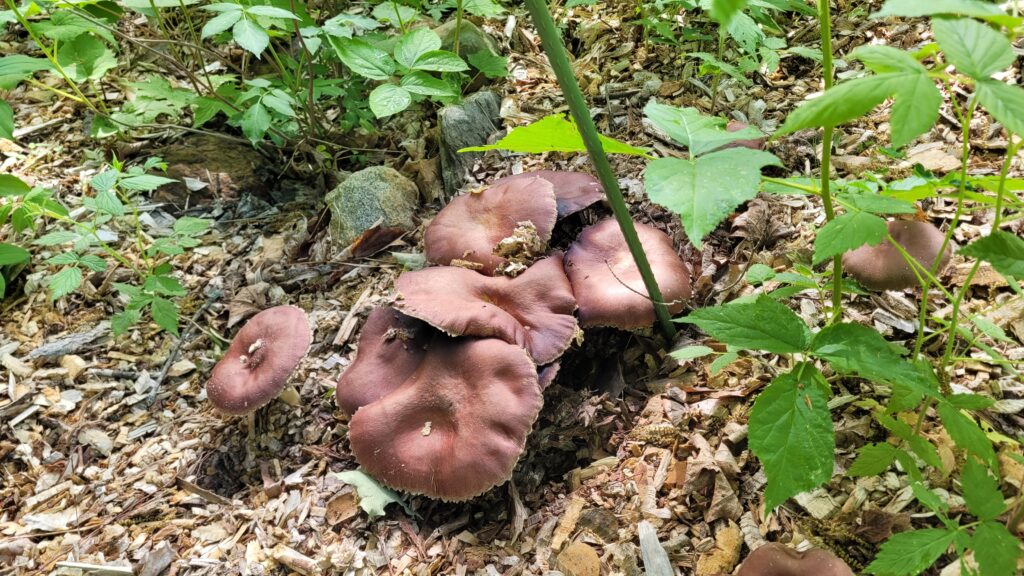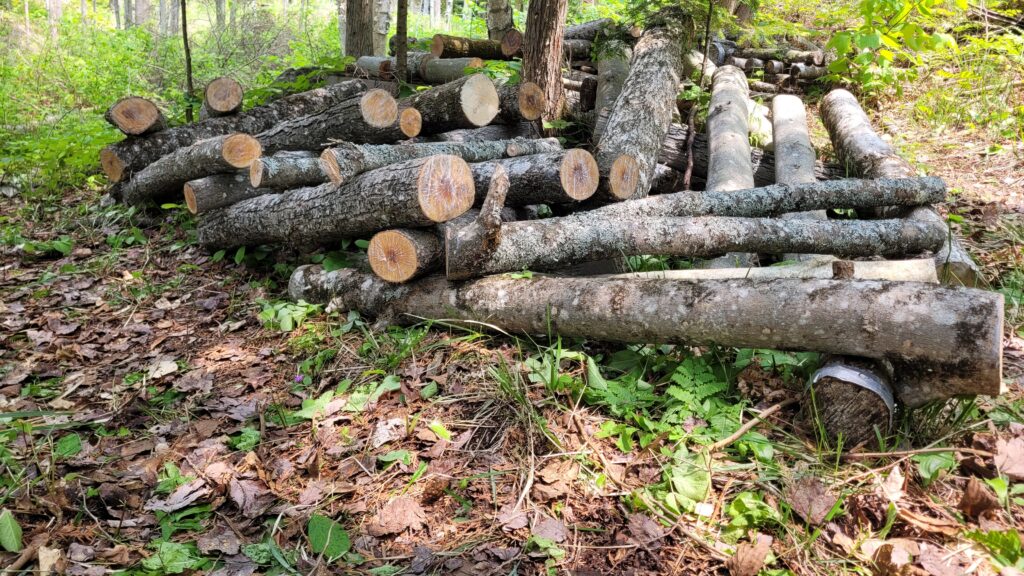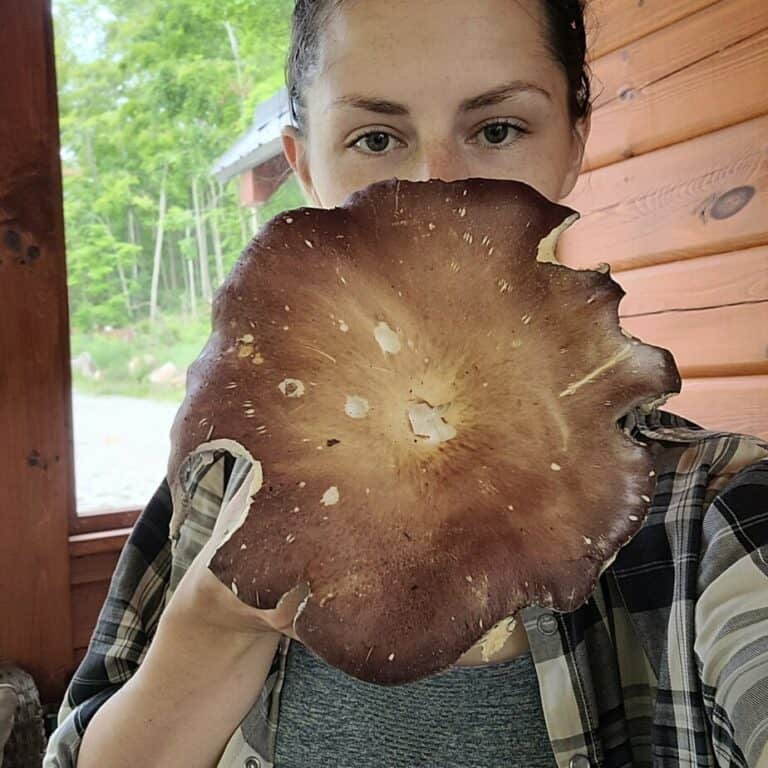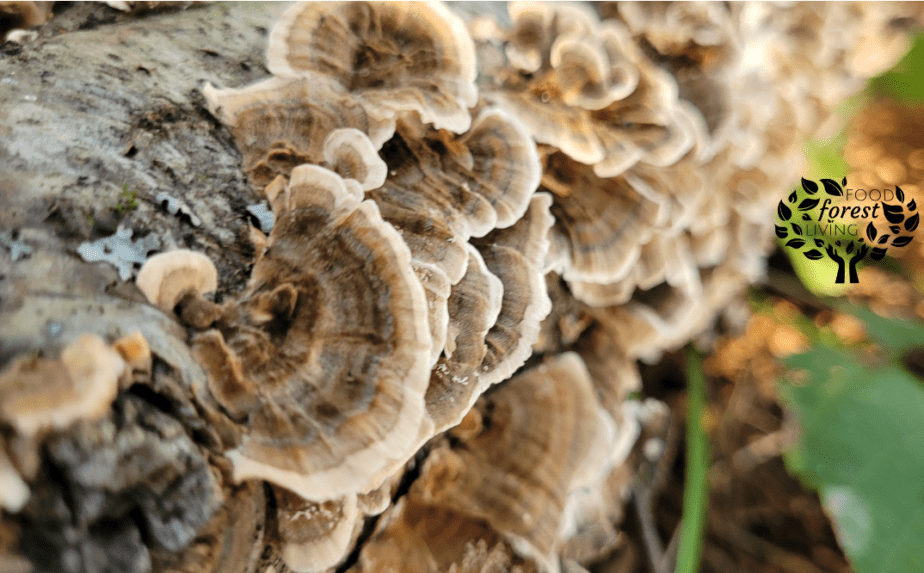This post may contain affiliate links. If you use these links to buy something we may earn a commission. Thanks.
Outdoor mushroom gardens are a rewarding and passive way to feed your family, make medicine, and use the shady areas of your backyard.
So welcome to the beginning! You’ll be guided from start to finish, through everything you need to know about how to grow a productive mushroom garden outdoors. This includes:
- How to grow edible gourmet mushrooms at home
- How to grow medicinal mushrooms at home
Various species of mushrooms can grow in your garden but each strain has their preferences. So it’s essential to choose mushrooms that are suitable for your climate and limitations.
While it may seem overwhelming at first, the benefits of growing mushrooms at home are well worth it—plant once, and harvest for years! . . . Plant every year; harvest, preserve, and share an endless life supply of nourishing mushrooms!
See: Why Grow Mushrooms at Home? 8 Practical Motives

Before you start, here’s everything you’ll need to be aware of:
- Basic requirements
- Outdoor growing methods
- Start-up and ongoing costs
- Types of mushrooms you can grow
- Best educational resources
1. Find a suitable location
When looking to cultivate gourmet mushrooms in your own backyard, you’ll need to know the essentials to do so successfully.
‘Where to grow your mushrooms’ is the very first question you should answer before you decide on anything else. Without a proper place to grow mushrooms, you won’t have much success.
Mushrooms will grow in any situation that fulfills the following criteria:
A shaded and moist place with minimal direct sunlight and good drainage are the basic requirements for growing mushrooms outdoors. The area should be able to receive rainfall, can be brightly lit, and is generally cool.
We had a few spots in mind but decided that the best place for our mushroom beds and logs was beneath the canopy of both coniferous and deciduous trees.
If you lack a canopy, place them anywhere in the shade that receives airflow and rain. Some possible places could include:
- Under an evergreen canopy
- On the shady side of the house
- On the shady side of a fence
- Under a rhubarb patch (or any other plant foliage!)
- The bottom of a hill
- Under a deciduous tree canopy
- Under paper bags (if no shaded area is available)
- Under an arbor covered with densely overgrown vines
Properly situated mushrooms won’t need manual watering unless you have a full week or more without rain. Snow coverage, during winter, will also keep your mushroom mycelium adequately moist.
Shade prevents evaporation and provides stable temperatures for optimal growth and, eventually, fruiting.
Some sun is okay! But it’s not ideal to attempt to grow mushrooms in full sun (6 or more hours of direct sun) positions.
With a spot in mind for your potential mushrooms, what’s the best way you can grow them?
2. Select a growing method
The best mushroom cultivation method depends on the resources available to you.
Outside, you can cultivate mushrooms in various ways. Some methods are easier than others, and the difference between each method is the substrate.
The substrate is the medium that your chosen mushroom will use to grow—much like a plant grows using soil.

So the question is, which substrate is easiest for you to obtain?
- Shredded materials like woodchips, straw, and leaves are used to make ‘mushroom beds’ for wood-loving species
- Manure is used to make mushroom beds for dung-loving species
- Whole hardwood logs from healthy trees are used to make ‘mushroom logs’ or ‘mushroom totems’ for wood-loving species
A mushroom bed using woodchips, straw, and leaves is the most popular way to grow mushrooms in the garden. These materials are widely accessible and several delicious and beginner-level species grow in hardwood-based beds.
Managing mushroom beds is like any perennial garden. But beyond suppressing weeds, you’re topping up the mulch each year to feed the mushroom mycelium. Mushrooms will continue to grow year after year and even spread around the garden.
- How to start making mushroom beds: What is a Mushroom Bed?
Dung-loving mushrooms, in general, are not recommended for beginners as they aren’t the easiest option.
Mushroom logs are the easiest way to open the doors to a wider variety of delicious gourmet species.
- How to start making mushroom logs: What is a Mushroom Log?
If you want to grow mushrooms beyond beds and logs, you can take things indoors, too for year-round mushroom harvests.
- More ways to start growing mushrooms: 6 Ways to Grow Mushrooms at Home (In + Outdoors)
Everyone who grows mushrooms has their own unique setup. Each made using their own budget and resources. With real-life examples, you’ll grasp a realistic idea of how much mushroom cultivation may cost you.
After we cover the cost considerations of each of the above mushroom-growing methods, we’ll dive into the different mushroom strains and their preferences.
How much it costs with real-life examples: What it Costs to Grow Mushrooms (Indoor vs Outdoor)
Now that you’re aware of all the options, here’s what you need to consider:
- Which species are suitable for you
- Potential challenges with outdoor mushroom cultivation
- What tools you’ll require
- Where to buy mushroom spawn or kits
- How to obtain substrates
3. Research and select mushroom species

Various mushroom species are best cultivated outdoors, after all, it’s where they grow wild!
Choosing between species is a matter of taste, texture, cultivation difficulty, preferred substrates, medicinal benefits, climate suitability, and more!
To simplify all these parameters and help you find the best mushrooms to grow, I’ve sorted them all into categories.
Choose the ones you’re interested in, and on the next page, you’ll be able to dig deeper into the details of each mushroom strain.
- Cold Climates: 11 Best Mushrooms to Grow in a Cold Climate Food Forest
- Easiest to grow: 4 Fail-Proof Mushrooms to Grow Outside
- Best tasting: 9 Best-Tasting Mushrooms to Grow & What They’re Like
- Most medicinal: 4 Easy Medicinal Mushrooms to Grow for Healing
- Best grown on logs: 9 Best Mushrooms to Grow on Logs (From Easy to Hard)
- Best grown in beds: What mushrooms are best for wood chips?
- Most profitable: Most profitable (edible and medicinal) mushrooms to grow
- Mushroom companion plants:
4. Learn more about mushroom cultivation

Growing food of any kind comes with unique challenges. The easiest way to get through is to learn more about the foundations. Understanding mushrooms and the way they interact with the natural world to grow and fruit is vital to your success.
As you dive into the world of growing mushrooms, the process makes a whole lot more sense after you become familiar with new terminology.
And renowned books in the industry are the best place to start.
If you’re serious about growing your own mushrooms and wish for good long-term harvests, Paul Stamets is the place to get the best information!
His book, Growing Gourmet & Medicinal Mushrooms, is a detailed ‘bible’ for growing all the delicious mushrooms mentioned in this post. You can get it for a discount using QUALITYSPAWN at checkout. Or if you don’t plan on ordering any mushroom spawn with Northspore, the book is also available here on Amazon.
If you live in a forested woodland, as we do, Farming the Woods is the perfect book for learning to grow fruit, nuts, herbs, animals, and of course mushrooms in temperate climate forests.
But, even if you don’t know all there is to know just yet, get started! As you do it, you’ll learn a lot.
Digging Deeper…

The links provided above are your starting point for choosing a branch to explore.
Below are the steps (in order) of what each branch will also entail.
So, either click into your desired branch above or keep this post open (or save it for later) for a linear library of everything and keep scrolling!
Bookmark this post to come back anytime.
Acquire essential tools
Before deciding which mushroom method is best for you, you’ll need to consider the necessary tools involved.
We knew we wanted to grow mushrooms using both outdoor methods and wondered what tools we’d need before we started.
You’ll need specific tools to inoculate mushroom logs, but not for mushroom beds. Mushroom beds are easier to inoculate as they don’t require any tools if you can find fresh woodchips and straw to buy.
See: Essential Tools to Make Mushroom Logs (Complete List)
If you’d like to make your own substrates for growing mushrooms outside, both methods will require tools. Substrates are growing mediums (straw, woodchips, or logs).
- To make straw, you may prefer something to plant the seeds and cut the harvest.
- To make woodchips, you’ll need saws to cut healthy trees and a chipper to chip the wood.
- To make mushroom logs, you’ll need saws to cut healthy trees.
Where to buy mushroom spawn or kit

Mushroom spawn is what you use to inoculate your substrate so they can colonize and later fruit. To grow mushrooms outdoors, you’ll need either grain, sawdust, or plug spawn.
“Spawn” is a single strain of mushroom grown onto a medium that is ready to expand onto
Grain and sawdust spawn can be used to make mushroom beds. The type of spawn depends on the preference of the mushroom strain. For example, wine caps come in sawdust spawn as they prefer hardwood ‘food’ rather than grain.
Sawdust and plug spawn can be used to make mushroom logs. Plug spawn is usually cheaper upfront than sawdust spawn as they require more basic tools for inoculating logs.
See: Essential Tools to Make Mushroom Logs (Complete List)
In general, we order spawn and tools from North Spore. Since they have a high turnover rate, their products are always fresh and as a beginner, the information provided tools are very straightforward.
High-quality mushroom spawn increases your success rates. The process, age, and storage of the spawn can all affect the strength of the mycelium and the longevity of your spawn before using it.
Many people have DIY’d their mushroom projects, too, and the cost of their setups is all different!
See: What it Costs to Grow Mushrooms (Indoor vs Outdoor)
Making your own spawn can also reduce the ongoing costs of mushroom cultivation whether you grow in or outside.
See: 6 Ways to Grow Mushrooms at Home (Compared)
Obtain and prepare the substrate

- Create mushroom beds
- Or cut logs…
The substrate is the material that mushrooms use to grow, similar to how plants need soil. Different mushrooms prefer particular substrates—earlier in this post, you were to explore mushroom species. From there, you’ll find more details on how to cultivate each with the best substrate.
But since you’re here, outdoor substrates for mushroom cultivation include straw, wood chips, logs, or a combination.
Obtaining and preparing substrates can be completely skipped over if you buy a done-for-you kit. That, however, is the most expensive way to grow mushrooms as you only get 1-3 flushes per kit. Plus, kits are grown indoors!
To grow mushrooms outside, you’ll need to obtain organic (untreated) substrates.
- Straw can be purchased from local farmers.
- Fresh wood chips can be dropped off by local arborists in need of a “dump site.”
- Logs are easiest to obtain if you have a hardwood woodland property to cut healthy dormant trees. See: How to Identify & Select Trees for Mushroom Logs (With Pics)
- If you don’t own hardwood trees, see: Where to Find Fresh Wood for Mushroom Logs (9 Places)
Preparing substrates for outdoor mushroom cultivation is a lot easier than indoors.
Beds:
For easy, aggressive-growing strains, you do not need to pasteurize your straw or woodchips before inoculating them with spawn.
Building a “box” frame using logs or rocks will help retain moisture in your mushroom bed. If you don’t make a small frame, similar to a short raised bed, the substrate may dry quicker. Your substrate should always have moisture, so we always ensure our beds are enclosed at the sides to minimize the need for manual watering.
See: How do you make (and maintain) an outdoor mushroom bed?
Logs:
Logs do not need to be pasteurized before plugging.
They do, however, need to drain before use. After we cut healthy dormant trees into logs, we sit them outside in the shade for 2-4 weeks. Depending on the wood type, the sap will drain in more or less time.
Sap is antifungal. So if you want to grow tasty fungus, it’s vital to allow the sap to drain from the wood before plugging your logs.
Logs shouldn’t sit longer than 6 months before use. If they’ve sat for more than 4 weeks, you’ll likely need to soak them for 24-48 hours before plugging to ensure they are moist enough for the mycelium to survive.
See: How to Use Mushroom Plugs Complete Guide
Ready to grow mushrooms in your garden?
Inoculate the substrate

Once you have your substrate ready, you need to introduce mushroom spawn. Introducing spawn to your substrates is referred to as “inoculating.”
Once you inoculate the substrate, your mushrooms spawn will grow mycelium (mushroom “roots”) to colonize the substrate. Later, once the mycelium has overtaken its space, it will fruit during its preferred temperature ranges.
In general, an average mushroom bed takes about 6-12 months to fruit and average mushroom logs take 1-2 years to fruit. This waiting period is the time they are spending to “colonize” the substrate.
To inoculate your substrates:
- For logs, see: How to Use Mushroom Plugs Complete Guide
Logs require a station and tools to inoculate and are later moved to their “spot.”
- For beds, see: How do you make (and maintain) an outdoor mushroom bed?
Beds are inoculated and watered in place.
Timelines expectations
See: How long does it take to make mushroom logs?
See: How Long Does It Take To Grow a Food Forest?
Maintain moisture
Moisture is vital for mushrooms! Water beds and logs when they don’t receive rain for over a week. Avoid drowning your beds and logs in too much water.
Beds should be deeply watered until they drain, but not soaked further.
Logs are best “watered” by soaking in a tub or steel drum for 12 hours (overnight). Soaking logs in drums is a lot of heavy lifting! This is why choosing the right location is important. A bright-lit but shaded spot that receives rain and snow is great. In an environment like that, you’ll only need to soak logs if it hasn’t rained for over 2-3 weeks. Or, if you wish to “shock” them into fruiting.
See: How To Care for Mushroom Logs (Everything You Need to Know)
Monitor and control pests
While rarely an issue, especially when getting started, you’d be prudent to prepare for pests.
Fruiting:
The good news is if you harvest your mushrooms often as they are fruiting, you’ll get them fresh and clean before the bugs get to them.
Even if the bugs do make their way over, you can soak mushrooms for 5-10 minutes, then air dry to rid them.
And beyond bugs, some bigger critters eat mushrooms too! Deer, rabbits, squirrels, and more won’t hesitate to take some of your mushrooms.
You could employ some simple tactics to keep them from finding your treasure trove. See: Schedule to Keep Deer Out of The Garden Without A Fence. In our experience, more than just deer are off-put by these strategies.
Colonizing:
Hopefully, your bed and logs are left alone as they colonize. Disturbances can slow progress and ultimately reduce yields in some cases.
Birds and other critters may rustle around in beds or peck at logs and damage bark.
Undisturbed beds are best, but not always possible. But, as they are the easiest to make, it isn’t the biggest deal if they get turned a bit.
For logs, however, bark integrity is important for keeping competition out, and moisture in! If the bark is damaged, simply be aware that the log may be prone to drying out faster.
Harvesting mushrooms

It’s recommended to pick or cut mushrooms one at a time to minimize substrate disturbance.
Overly mature mushrooms with holes and bugs are best left behind.
Ensure that you identify mushrooms correctly before consuming them, even when cultivated.
Mushrooms keep in the fridge for different lengths of time. Eat your mushrooms as fresh as possible, or dry them for later use.
Mushroom grower communities
- Facebook: Mushroom Cultivation Community
- Reddit: Mushroom Growers
Recent Posts
There’s no shortage of full-sun ground covers for zone 4 climates! Each plant in this list can withstand the frigid temperatures and also enjoy the hot sun in summer. Full sun means that a plant...
There's no shortage of full sun ground covers, not even in zone 3! Zone 3 climates offer hot but short-lived summers and very cold winters. So each plant in this list can withstand the frigid...
